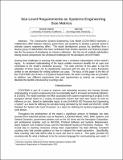| dc.contributor.author | Valerdi, Ricardo | |
| dc.contributor.author | Raj, Jatin | |
| dc.date.accessioned | 2014-01-23T16:42:04Z | |
| dc.date.available | 2014-01-23T16:42:04Z | |
| dc.date.issued | 2005-07-10 | |
| dc.identifier.uri | http://hdl.handle.net/1721.1/84160 | |
| dc.description.abstract | The Constructive Systems Engineering Cost Model (COSYSMO) represents a
collaborative effort between industry, government, and academia to develop a general model to
estimate systems engineering effort. The model development process has benefited from a
diverse group of stakeholders that have contributed their domain expertise and historical project
data for the purpose of developing an industry calibration. But the use of multiple stakeholders
having diverse perspectives has introduced challenges for the developers of COSYSMO.
Among these challenges is ensuring that people have a consistent interpretation of the model’s
inputs. A consistent understanding of the inputs enables maximum benefits for its users and
contributes to the model’s predictive accuracy. The main premise of this paper is that the
reliability of these inputs can be significantly improved with the aide of a sizing framework
similar to one developed for writing software use cases. The focus of this paper is the first of
four COSYSMO size drivers, # of Systems Requirements, for which counting rules are provided.
In addition, two different experiments that used requirements as metrics are compared to
illustrate the benefits introduced by counting rules. | en_US |
| dc.rights | Attribution-NonCommercial-ShareAlike 3.0 United States | * |
| dc.rights.uri | http://creativecommons.org/licenses/by-nc-sa/3.0/us/ | * |
| dc.subject | constructive systems engineering cost model (COSYSMO) | en_US |
| dc.subject | systems engineering (SE) | en_US |
| dc.title | Sea Level Requirements as Systems Engineering Size Metrics | en_US |
| dc.type | Presentation | en_US |
| dc.type | Technical Report | en_US |
